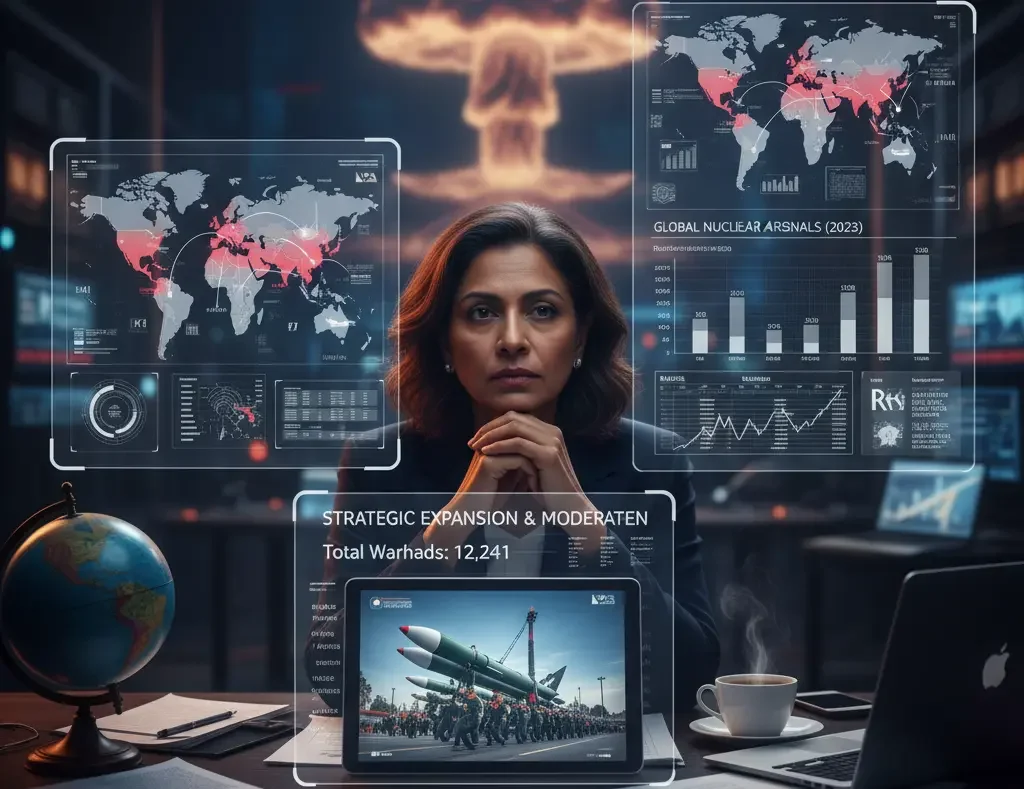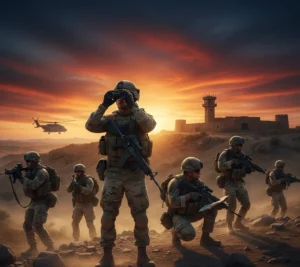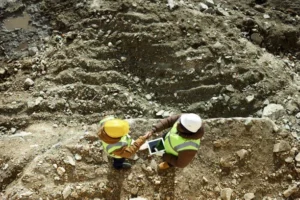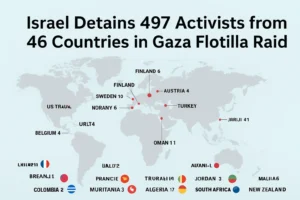As of January 2025, only nine countries possess nuclear weapons. Together, they hold about 12,241 nuclear warheads, with almost four out of five warheads kept in military stockpiles rather than fully retired. The long post–Cold War phase of gradual disarmament has effectively ended. In its place, the world is entering a period of strategic expansion and modernization, where existing nuclear states are upgrading their arsenals and some are quietly increasing their numbers.
This article gives a clear, data-driven look at which countries have nuclear weapons, how many they have, and why they keep them, using 2025 statistics and current strategic trends.
Global Nuclear Weapons by Nation: 2025 Snapshot
In early 2025, the global stockpile looks like this:
- Total global warheads: 12,241
- Military stockpiles (usable warheads): 9,614, about 78.6% of the total
- Deployed warheads with operational forces: 3,912
- High-alert warheads (ready to launch within minutes): ≈ 2,100, mostly on Russian and U.S. ballistic missiles or bomber bases
Although this is far below the estimated 70,000+ warheads of the mid-1980s, today’s arsenals are vastly more accurate, flexible, and integrated into each country’s broader defense strategy.
Nuclear Weapon by Country (2025)
Two countries dominate: Russia and the United States. Together, they hold 10,636 warheads, or about 86.9% of all nuclear weapons on Earth. The other seven nuclear-armed states collectively possess just over 1,600 nuclear weapons.
Nuclear Weapons Countries List – 2025 Stockpiles
| Country | Total Warheads | Deployed Warheads | Status (2025) | Change 2024–2025 |
| Russia | 5,459 | 1,718 | Active, modernizing | −71 |
| United States | 5,177 | 1,770 | Active, modernizing | −8 |
| China | 600 | 0 | Rapidly growing | +100 |
| France | 290 | 288 | Stable | 0 |
| United Kingdom | 225 | 120 | Growing (modernizing) | 0 |
| India | 180 | 0 | Growing | +8 |
| Pakistan | 170 | 0 | Stable (modernizing) | 0 |
| Israel | 90 | 0 | Stable (undeclared) | 0 |
| North Korea | 50 | 0 | Growing | 0 |
These figures reflect total inventories, including deployed warheads, reserve stockpiles, and warheads awaiting dismantlement.
Nuclear Weapons Spending by Country (2024–2025)
| Country | Estimated Nuclear Weapons Spending (2024–2025) | Warheads (2025 Estimate) |
| United States | $56.8 billion | 5,177 (1,770 deployed) |
| China | $12.5 billion | 600 |
| United Kingdom | $10.4 billion | 225 |
| Russia | $8.1 billion | 5,459 |
| India | $2.6 billion | 180 |
| Pakistan | ~$1.2 billion | 170 |
| France | Not publicly disclosed | 290 |
| Israel | $1.1 billion | 90 |
| North Korea | Not publicly disclosed | 50 |
Summary Insight
- Global nuclear weapons spending in 2024 surpassed $100 billion, an 11% annual increase.
- The U.S. alone accounts for more than half of global nuclear spending.
- China, the UK, and Russia follow, driven by modernization and regional tensions.
- India and Pakistan continue regional competition with steady but smaller budgets.
- Israel and North Korea maintain secretive but active nuclear development programs.
How the Global Arsenal Is Distributed
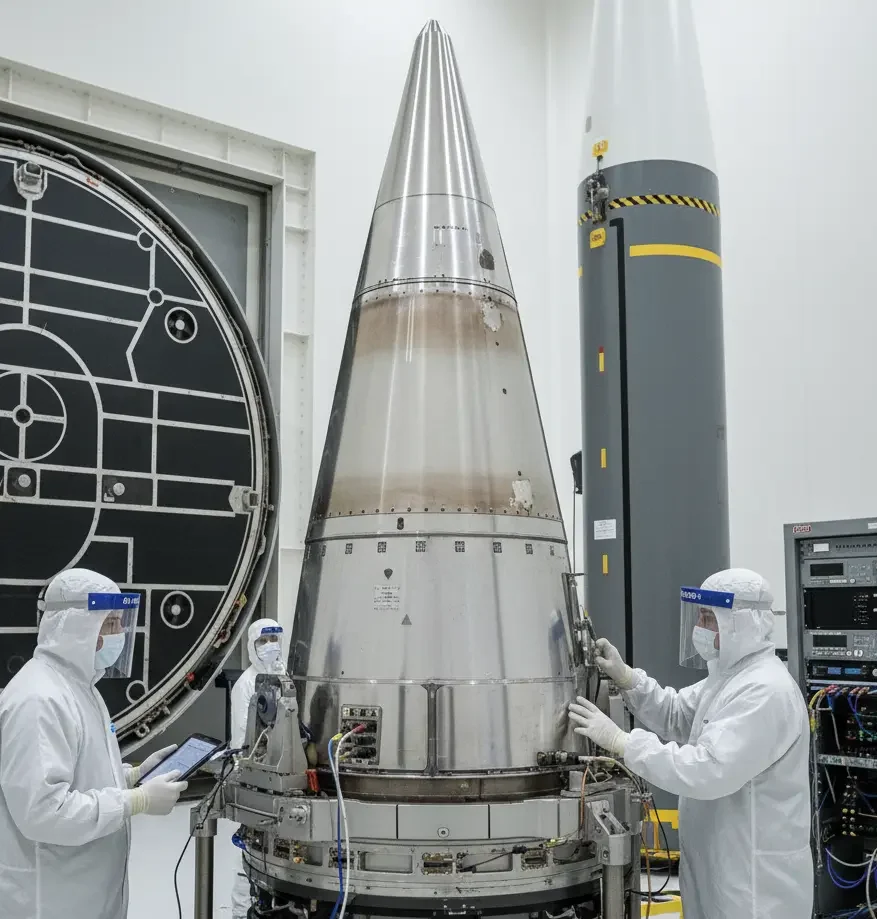
By percentage share of the global total (12,241 warheads):
- Russia: 5,459 warheads – about 44.6% of the global total
- United States: 5,177 warheads – about 42.3%
- All other seven nuclear states combined: 1,605 warheads – 13.1%
Despite modest year-on-year reductions in some totals (for example, Russia and the U.S. dismantling small numbers of warheads), the core military stockpiles are stable or growing, and the quality of systems is improving.
Warhead Deployment and Operational Readiness
Not every warhead is kept on a missile or aircraft. In 2025, nuclear warheads fall into three broad categories:
- Deployed warheads:
About 3,912 warheads are deployed on missiles or at operational bases.
Of these, roughly 2,100 are on high alert, mainly in the US and Russian arsenals, and are able to be launched within minutes. - Non-deployed military stockpile:
The remaining 9,614 warheads in military stockpiles are stored in central facilities, ready to be mated to delivery systems if needed. - Retired warheads awaiting dismantlement:
Around 2,627 warheads are officially retired but remain intact, pending dismantlement. These are not counted as part of active military forces but still exist physically.
This pattern shows why nuclear weapons remain central to war deterrence: even with lower totals than during the Cold War, states keep large numbers of warheads available on relatively short timelines.
Countries With Nuclear Arsenals: Who Has What and Why
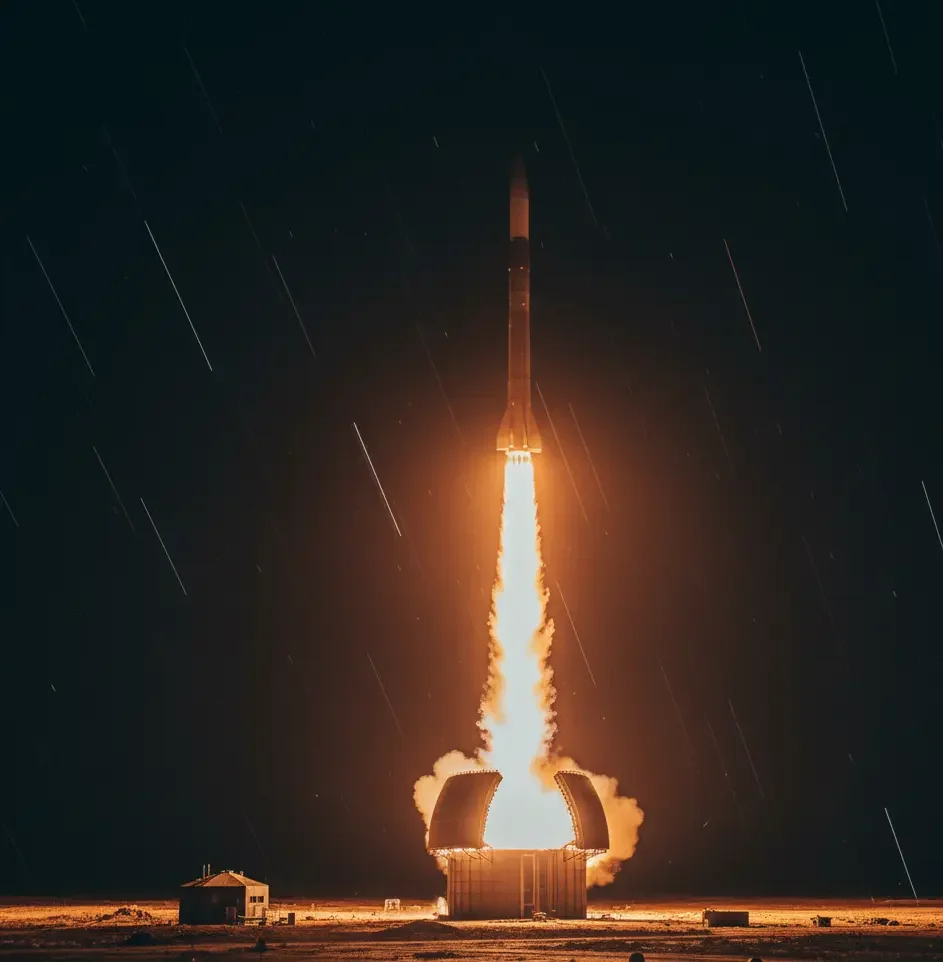
Although every nuclear-armed state is different, some common reasons explain why they maintain atomic bombs and missiles.
United States and Russia: Legacy Superpowers
- Both countries inherited massive arsenals from the Cold War.
- They still rely on significant, triad-based deterrents:
ICBMs, submarine-launched ballistic missiles (SLBMs), and strategic bombers. - While total numbers slowly drift downward, both are engaged in expensive modernization programs:
- The US is replacing land-based missiles, submarines, bombers, and warheads, with projected costs of about $946 billion between 2025 and 2034.
- Russia is deploying new ICBMs and advanced systems while keeping a large deployed force.
For both countries, nuclear weapons are not just tools of last resort; they are woven into planning for extended deterrence, alliance commitments, and global military power.
Also Read: Top 10 Most Powerful Militaries in the World
Nuclear Weapons in China: The Fastest-Growing Arsenal
China is the most dynamic nuclear state in 2025:
- Its arsenal grew from around 500 to 600 warheads in a single year, a 20% increase.
- It has built hundreds of new ICBM silos and is shifting from a limited “minimum deterrence” posture to a more robust nuclear triad:
- Land-based intercontinental missiles
- Submarine-launched ballistic missiles
- Air-delivered systems
China’s expansion is driven by:
- Concern about US missile defenses and advanced conventional strike systems
- Regional tensions in the Indo-Pacific, especially around Taiwan and the South China Sea
- A desire for assured second-strike capability and parity in status with other major nuclear states
Some defense assessments suggest that, if current trends continue, China could possess around 1,500 warheads by 2035. Whether or not it reaches that level, the clear direction is toward a much larger and more survivable nuclear force.
France and the United Kingdom: Smaller but Sophisticated Nuclear States
- France maintains about 290 warheads, almost all deployed on submarine-launched missiles. Its arsenal is stable but being upgraded with new missiles and improved warheads, preserving an independent deterrent.
- The United Kingdom holds 225 warheads, with about 120 deployed on Trident submarines. The UK:
- Has announced a higher cap on its total warheads
- Is investing in new Dreadnought-class submarines and a next-generation warhead program
- Relies entirely on its sea-based deterrent for nuclear defense
For both European nuclear states, the core logic is national survival, strategic autonomy, and alliance credibility within NATO.
Also Read: NATO vs BRICS 2025: Military and Economic Power Clash
India and Pakistan: Regional Rivals
- India has around 180 warheads, adding about eight in 2025. It is:
- Extending the range of its missiles
- Testing MIRV-capable systems to put multiple warheads on a single missile
- Developing sea-based components for a more secure second-strike capability
- Pakistan keeps about 170 warheads, with emphasis on:
- Ballistic and cruise missiles tailored to the Indian theater
- Tactical nuclear weapons are intended to counter significant conventional incursions
Both countries see nuclear weapons as essential in their long-running security rivalry. Each round of modernization and testing by one side tends to trigger a response from the other, feeding a regional weapons race.
Israel: Deterrence Through Ambiguity
- Israel is assessed to have around 90 nuclear warheads.
- It neither confirms nor denies possessing nuclear weapons, maintaining a policy of strategic ambiguity.
- Its aim is understood as:
- Deterring potential existential threats from hostile states or coalitions
- Ensuring a guaranteed second-strike capability, likely via submarine-launched systems
In a region marked by recurring wars and ongoing tension, this ambiguity is itself a central part of Israel’s deterrence strategy.
North Korea: Small Arsenal, Outsized Risk
- North Korea has assembled roughly 50 warheads and has fissile material for up to 40 more.
- It conducts frequent missile tests and openly presents nuclear weapons as vital to regime survival.
- According to regional assessments, Pyongyang is:
- Increasing fissile material production
- Developing tactical nuclear weapons
- Working on longer-range missiles that can reach the US and allied territories
Though much smaller than the arsenals of Russia, the US, or China, North Korea’s weapons add severe instability to the Korean Peninsula and Northeast Asia.
Atomic Weapons Development: From Stockpiles to Modern Systems

Modern nuclear forces are defined less by raw numbers and more by:
- Accuracy (hitting hardened military targets)
- Survivability (especially submarines and mobile launchers)
- Flexibility (ranging from low-yield tactical warheads to large strategic ones)
- Delivery diversity:
- Silo-based and road-mobile intercontinental ballistic missiles
- Submarine-launched ballistic missiles
- Air-launched cruise missiles and strategic bombers
- Emerging hypersonic vehicles
Most nuclear states are investing in new delivery systems rather than massively enlarging stockpiles. This reflects a shift from simple “counting warheads” to building a more resilient, penetrating, and controllable nuclear posture.
Key Trends and Strategic Shifts in 2025
1. End of the Disarmament Era
For roughly 30 years after the Cold War, the number of nuclear weapons in the world dropped steadily as the US and Russia dismantled thousands of retired warheads. That trend is now reversing:
- The total global inventory is no longer falling as quickly.
- The number of warheads in military stockpiles is rising in several countries.
- New systems are entering service faster than old ones are removed.
Analysts now describe this as the end of the post–Cold War disarmament phase and the beginning of a new cycle of nuclear competition.
2. Accelerating Modernization
Almost all nine nuclear-armed countries are modernizing:
- Russia is upgrading its strategic missiles and deploying new systems designed to carry more warheads and defeat missile defenses.
- The United States is investing heavily in:
- New land-based missiles
- New ballistic-missile submarines
- New strategic bombers
- New command-and-control infrastructure
The projected $946 billion US nuclear budget for 2025–2034 highlights just how central nuclear forces remain in long-term planning.
3. Weakening Arms Control
The arms control framework that helped manage nuclear risks is fraying:
- Russia suspended participation in the New START Treaty in 2023, and the agreement is due to expire in February 2026 with no replacement in sight.
- Verification and inspection mechanisms have been rolled back, reducing transparency.
- No global treaty limits nuclear weapons in countries outside the US–Russia framework, such as China, India, Pakistan, or North Korea.
The result is a world with more modern weapons, fewer rules, and less trust between major powers.
4. New Nuclear Races and Regional Flashpoints
Several regional conflicts interact with nuclear arsenals:
- Russia’s invasion of Ukraine and sharpened nuclear rhetoric have pushed nuclear risks back into public debate.
- Tensions in the Middle East, including Israel’s security environment, and in the Korean Peninsula, add further uncertainty.
- In Asia, the interplay between China, India, Pakistan, and North Korea is creating overlapping layers of competition, testing the limits of arms control and crisis management.
Strategic Implications: Why Nuclear Weapons Still Matter
Despite efforts by some nations to promote arms control and non-proliferation, nuclear weapons remain central tools of global security policy:
- Their possessors see them as the ultimate insurance policy against large-scale attack.
- They give states leverage in diplomatic crises and negotiations.
- They raise the stakes of regional wars, making miscalculation more dangerous.
Experts warn that, even with far fewer warheads than at the 1980s peak, the risk of nuclear use in 2025 may be as high—or higher—because:
- More countries have nuclear arsenals.
- More regional conflicts sit near nuclear fault lines.
- Arms-control agreements are weaker.
- Advanced technologies (such as cyber operations, AI-assisted targeting, and hypersonic missiles) compress decision times and complicate early warning systems.
Also Read: The Arms Race 2025: Who’s Spending the Most on Weapons and Why It Matters
Conclusion
The 2025 nuclear landscape is defined by nine atomic states, 12,241 warheads, and a clear shift away from disarmament toward modernization and expansion. Russia and the United States still hold nearly nine out of ten warheads. Still, China, India, Pakistan, and North Korea are reshaping the balance through steady growth and new delivery systems.
Understanding which countries have nuclear weapons and why is no longer a Cold War history lesson. It is a live question at the heart of today’s global security, arms control debates, and geopolitical tensions.
FAQs
Can a country legally withdraw from the Nuclear Non-Proliferation Treaty (NPT)?
Yes. A country can legally withdraw by giving three months’ notice and citing national security concerns, as North Korea did in 2003.
Which nuclear-armed countries have a “no first use” policy?
Only China and India officially maintain a declared “no first use” policy, though interpretations and conditions vary.
Can nuclear weapons be launched accidentally?
Accidental launch is extremely unlikely due to multilayered safeguards, strict command procedures, and early-warning verification systems. However, false alarms have occurred historically.
Are there countries capable of building nuclear weapons quickly if they choose to?
Yes. Nations like Japan, South Korea, and Germany have advanced technology and materials, giving them the potential to develop nuclear weapons relatively quickly, although all remain committed to non-proliferation.






